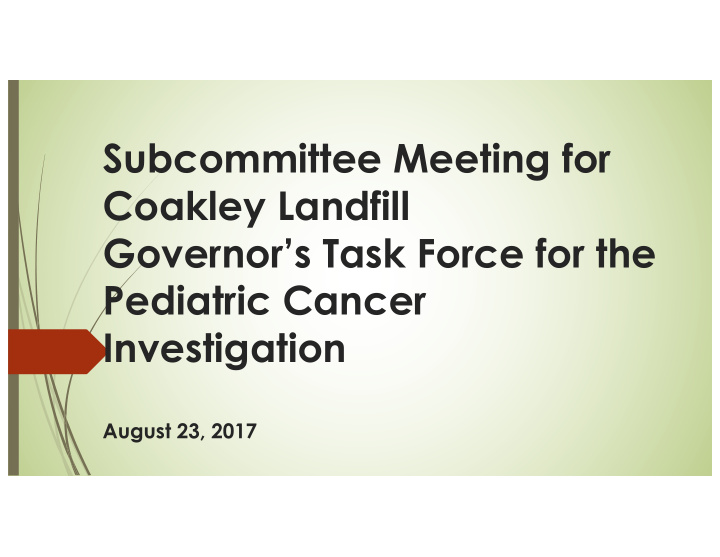



Subcommittee Meeting for Coakley Landfill Governor’s Task Force for the Pediatric Cancer Investigation August 23, 2017
New Hampshire and Cancer ´ CDC- Defined Double Pediatric Cancer Cluster – 5 town area of Seacoast - RMS, PPB and brain cancer ´ New Hampshire has the highest incidence rate of breast cancer in the country. ´ New Hampshire has a higher incidence rate for many types of cancer than Vermont.
Subcommittee for Coakley Landfill Governor’s Task Force for the Pediatric Cancer Investigation Subcommittee Process ´ Series of Public Meetings ´ Scientific Inquiry – had input from: ´ NHDES ´ USEPA ´ USGS ´ Rye Town Water ´ Public ´ Coakley Landfill Group ´ Comprehensive Historical Documentation Review ´ Subcommittee Members Met with Abutting Landowners ´ Site Walk
Coakley Landfill Location Rye Landfill Four Brooks originate west of Coakley RYE Grove Road Landfill Coakley Landfill Lafayette Terrace
1984 aerial photo – near new development area
1984
Interim Report from the Subcommittee for Coakley Landfill Governor’s Task Force for the Pediatric Cancer Investigation Finding: Bedrock is porous – lots of potential for migration of contamination. New Castle Bedrock Rye Bedrock
Finding: Groundwater Flow is radial (in all directions from the landfill). Simulated Bedrock Aquifer Groundwater level 10-ft contours
Interim Report from the Subcommittee for Coakley Landfill Governor’s Task Force for the Pediatric Cancer Investigation Model Cross Section Great Atlantic Bay Ocean Eliot, Breakfast Hill, Berwick Fm. Rye Fm. Kittery Fm. Estimated that more than half of the water storage is in the upper sediments and about 1/3 of that is in sand and gravel
2015 1,4-dioxane $
Lineaments and highly fractured bedrock At Bailey Brook test well shown in: USGS Open-File Report 98-558
1,4-Dioxane in Bedrock 2013 and 0.42 2015 ug/L 2013 in 2013 Well on golf club 0.74 ug/l (2015) 2015
Prevalence of fluorinated chemicals in U.S. fast food packaging PIGE Gamma$ray$Counts$/$µC (total fluorine) Popcorn'bag' (w/'PFAS) Copier'paper (blank) Schaider et al . 2017. ES&T Letters. 4(3):105– Energy 111.
PFCs do not degrade in the environment and “bioaccumulate” in our bodies through a variety of exposure pathways. Photo Credit: The Sensitive Life www.thesensitivelife.weebly.
In May 2016, EPA issued stricter drinking water guidelines for PFOS and PFOA § 2009 guidelines: ´ 200 ng/L PFOS, 400 ng/L PFOA § 2016 guideline: ´ PFOS + PFOA: 70 ng/L § Guidelines lacking for other PFASs § Some states have lower guidelines NJ - noted effects on mammary gland development, proposed 14 ppt for § PFOA Vermont - 20 ppt total PFCs, early childhood § Minnesota – 35 ppt for PFOA and 27 for PFOS - infant §
Most of the PFCs come from Drinking Water Exposure – serum levels 5 to 8 times higher than the US average from drinking 70 ppt PFOA 5-8 x higher
C8 Science Panel Study 1. Minimum exposure of 50 ppt PFOA (http://www.c8sciencepanel.org/prob_lin 2. 69,000 exposed People Studied k.html) 3. Probable links to testicular and kidney cancer, thyroid disease, pregnancy-induced hypertension, autoimmune disease, high cholesterol. Other studies determined ADHD. 4. Total so far of $1.5B in DuPont Payouts
HB485 retained in finance. HB 463; Amendment 2017-1678s proposes the adoption of criteria for emerging contaminants in drinking water with the most conservative approach to exposure for children and other vulnerable populations-
Surface water issues need attention 1.Only brook really evaluated Berry’s Brook 2.Fish stocking – 5,000 per year in Berry’s Brook 3.Need full length investigation of all brooks originating at Coakley 4.PFCs at high levels in Berry’s Brook tied to Coakley
Coakley LF Aquarion Wells in North Hampton and Hampton Well 6
Rye – Grove Road Landfill Coakley LF
Rye – Grove Road Landfill
Rye – Grove Road Landfill State and EPA passed off to Rye
Draft Recommendations ´ 1. DRINKING WATER PROTECTION ´ 2. SLOW/MONITOR ASSESS THE MIGRATION ´ 3. ASSESSING THE PROBLEM ´ 4. PUBLIC HEALTH ASSESSMENT ´ 5. FUTURE COMMITTEE/REGULATORY COORDINATION
Updates Since Interim Report 1. DES Letter ´ ´ Signs need to be posted ! ´ Fish need to be assessed in Berry’s Brook ´ Need to mitigate contamination in brooks ´ BUT DES and EPA say they have no authority to compel remediation ´ Greenland and Portsmouth have submitted a proposal to the MTBE fund to access funding for water lines to serve Breakfast Hill Road ´ Rye Landfills – PFCs detected at levels in excess of AGWQS ´ All Rye wells show increasing PFOA and PFOS not decline ´ Hampton/North Hampton Aquarion wells, closing of Well MW-6 (20 ppt to 87 ppt in a year). ´ Other wells nearby also saw increasing concentrations
Recommendations ´ We have elevated levels of pediatric cancers ´ We know there is unmitigated flow in surface water and groundwater. ´ Original remediation plan relied on natural attenuation ´ PFCs don ’ t attenuate ´ Flow into Greenland private wells and residential areas ´ Flow into Rye (Bedrock), North Hampton and Hampton ´ Historical cancer cases in North Hampton – Lafayette Terrace ´ Increasing PFC concentrations year over year in Aquarion wells and RWD wells ´ Private wells exist in Greenland, Rye (Bedrock wells RWD), North Hampton where levels of PFCs are below current NHDES AGWQS ´ THEREFORE - REMEDIATE!
Recommend
More recommend